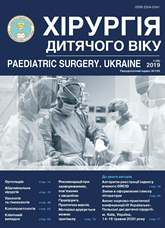Rare clinical case of surgical treatment of bilateral stage iii hydronephrosis in a newborn baby
DOI:
https://doi.org/10.15574/PS.2019.65.62Keywords:
congenital developmental defect, kidney, bilateral hydronephrosis, pylourethral segment, surgical correction, newborn babyAbstract
The article presents a rare clinical case of treatment of a newborn baby with a birth defect in the development of both kidneys – bilateral hydronephrosis III degree. At the age of 11 days the child underwent a radical one-stage operative treatment – resection of the pyeloureteral segment followed by the imposition of a pyeloureteral anastomosis by the Anderson-Hines method of the left and right kidneys.The result of the surgical correction of the presented developmental malformation is good.The research was carried out in accordance with the principles of the Helsinki Declaration. The study protocol was approved by the institution’s Local Ethics Committee. The informed consent of the child’s parents was obtained from the studies.
References
Beknazarov ZhB, Agzamkhodzhaev ST, Abdullaev ZB, Sanginov ShA. (2018). Results of surgical correction of congenital hydronephrosis in young children. Russian Bulletin of Pediatric Surgery, Anesthesiology and Resuscitation. 8;1: 31-35.
Big medical encyclopedia. Updated and updated edition of the bestseller (2015). Moscow: 146-148.
Jenlaev BK, Botabaeva AS, Kaliyeva ShS. (2015). Congenital hydronephrosis in children. Clinical Protocols of the Ministry of Healthcare and Social Development. MedElement.
Degtyar VA, Boyko MV, Kharitonyuk LM, Hitrick AL, Ostrovskaya AA, Obertinsky AV, Varun SE. (2017). Some aspects of diagnostics and treatment of pediatric patients with hydronophrosis. Paediatric surgery.Ukraine. 3(56): 89-92. https://doi.org/10.15574/PS.2017.56.89
Isakov YuF, Dronov AD. (2009). Pediatric surgery: National leadership. Moscow: GEOTAR-Media: 583-589.
Clinical recommendations for the diagnosis and treatment of hydronephrosis and ureterohydronephrosis. Russian Society of Urology. XIV Congress of the Russian Society of Urology (Saratov, Russia, September 10–12, 2014).
Kokorkin A.D. (2016). Early diagnosis and treatmente of hydronephrosis in childhood. Sovremennaya pediatriya. 1(73): 139-141. https://doi.org/10.15574/SP.2016.73.139
Lyamzin SI. (2007). Obstruction of the pyeloureteral segment in young children (principles of pre- and early postnatal diagnosis and improvement of surgical treatment): abstract dis. cand. medical sciences. Omsk.
Menovshchikova LB, Rudin YuE, Germanova TN. (2015). Clinical guidelines on pediatric urology – andrology. Moscow: Pero: 8-24.
Nikitina ON, Kalashnikova EA, Galich SR, Sochi TV. (2018). Diagnosis, clinic, treatment and prognosis of renal hydronephrosis. Integrative Anthropology. 1(31): 60-62.
Rudin YuE. (2000). Tactics of treatment of hydronephrosis in young children. Pediatric Surgery. 3: 14-16.
Sizonov VV. (2016). Lecture. Diagnosis of obstruction of the pyeloureteral segment in children. Herald of Urology. 4.
Shevchuk DV, Voloshin PІ. (2016). To the issue of urine withdrawal with congenital hydronephrosis in children. Child health. 5 (73): 147-153. https://doi.org/10.22141/2224-0551.5.73.2016.78319
Yanitskaya MYu, Proklova LV, Kirkalova TI, Savenkov IYu, Belyaev IP, Berkausova IA. (2007). Percutaneous nephrostomy puncture under ultrasound control in children. Tezysi scientific papers symposium of pediatric surgeons of Russia J of Medical Science. 2(16): 81-82.
Bragagnini P et al. (2016, Des). Predictive factors of the outcomes of prenatal hydronephrosis. Arch Esp Urol. 69(10): 680-690.
Chertin B, Pollack A, Koulikov D et al. (2006). Conservative treatment of ureteropelvic junction obstruction in children with antenatal diagnosis of hydronephrosis: lessons learned after 16 years of follow-up. Eur. Urol. 49(4): 734-738. https://doi.org/10.1016/j.eururo.2006.01.046; PMid:16504374
Dias CS, Silva JM, Pereira AK et al. (2013). Diagnostic accuracy of renal pelvic dilatation for detecting surgically managed ureteropelvic junction / obstruction. J Urol. 190; 2: 661–666. https://doi.org/10.1016/j.juro.2013.02.014; PMid:23416643
Li G et al. (2017, Oct. 4). Perinatal and follow-up outcome study of fetal anomalies with multidisciplinary consultation. Ther Clin Risk Manag. 13: 1303–1307. https://doi.org/10.2147/TCRM.S138808; PMid:29042787 PMCid:PMC5634374
Nguyen HT, Herndon CD, Cooper C et al. (2010, Jun) The Society for Fetal Urology consensus statement on the evaluation and management of antenatal hydronephrosis. Journal of Pediatric Urology. 6; 3: 212-231. https://doi.org/10.1016/j.jpurol.2010.02.205; PMid:20399145
Onen A, Jayanthi VR, Koff SA. (2002). Long-term followup of prenatally detected severe bilateral newborn hydronephrosis initially managed nonoperatively. J Urol. 168(3): 1118–20. https://doi.org/10.1016/S0022-5347(05)64604-6
Downloads
Issue
Section
License
The policy of the Journal “PAEDIATRIC SURGERY. UKRAINE” is compatible with the vast majority of funders' of open access and self-archiving policies. The journal provides immediate open access route being convinced that everyone – not only scientists - can benefit from research results, and publishes articles exclusively under open access distribution, with a Creative Commons Attribution-Noncommercial 4.0 international license(СС BY-NC).
Authors transfer the copyright to the Journal “PAEDIATRIC SURGERY.UKRAINE” when the manuscript is accepted for publication. Authors declare that this manuscript has not been published nor is under simultaneous consideration for publication elsewhere. After publication, the articles become freely available on-line to the public.
Readers have the right to use, distribute, and reproduce articles in any medium, provided the articles and the journal are properly cited.
The use of published materials for commercial purposes is strongly prohibited.

